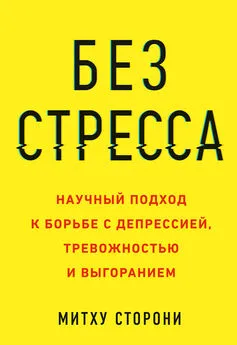Митху Сторони - Без стресса. Научный подход к борьбе с депрессией, тревожностью и выгоранием
- Название:Без стресса. Научный подход к борьбе с депрессией, тревожностью и выгоранием
- Автор:
- Жанр:
- Издательство:Литагент МИФ без БК
- Год:2019
- Город:Москва
- ISBN:978-5-00117-633-6
- Рейтинг:
- Избранное:Добавить в избранное
-
Отзывы:
-
Ваша оценка:
Митху Сторони - Без стресса. Научный подход к борьбе с депрессией, тревожностью и выгоранием краткое содержание
На русском языке публикуется впервые.
Без стресса. Научный подход к борьбе с депрессией, тревожностью и выгоранием - читать онлайн бесплатно ознакомительный отрывок
Интервал:
Закладка:
26
B. M. Egan, «Insulin Resistance and the Sympathetic Nervous System». Current Hypertension Reports 5, no. 3 (Jun. 2003): 247–254.
27
V. Zotev, R. Phillips, K. D. Young, W. C. Drevets, and J. Bodurka, «Prefrontal Control of the Amygdala During Real-time fMRI Neurofeedback Training of Emotion Regulation.» PLoS ONE8 (2013): e79184.
28
E. Fuchs, G. Flugge, and B. Czeh, «Remodeling of Neuronal Networks by Stress.» Frontiers in Bioscience 1, no. 11 (Sept. 2006): 2746–2758.
29
R. S. Duman, «Pathophysiology of Depression and Innovative Treatments: Remodeling Glutamatergic Synaptic Connections.» Dialogues in Clinical Neuroscience 16, no. 1 (Mar. 2014): 11–27.
30
S. L. Christiansen, K. Højgaard, O. Wiborg, and E. V. Bouzinova EV, «Disturbed Diurnal Rhythm of Three Classical Phase Markers in the Chronic Mild Stress Rat Model of Depression.» Neuroscience Research 110 (Sept. 2016): 43–48.
31
Y. Wu, L. Dissing-Olesen, B. A. MacVicar, and B. Stevens, «Microglia: Dynamic Mediators of Synapse Development and Plasticity». Trends in Immunology 36, no. 10 (2015): 605–613.
32
A. Kleinridders, H. A. Ferris, W. Cai, and C. R. Kahn, «Insulin Action in Brain Regulates Systemic Metabolism and Brain Function». Diabetes 63, no. 7 (Jul. 2014): 2232–2243.
33
Ангедония – снижение или утрата способности получать удовольствие от любимой деятельности (спорт, хобби, музыка, сексуальная активность и социальные взаимодействия), сопровождающееся потерей активности в его достижении.
34
A. J. Loonen and S. A. Ivanova, «Circuits Regulating Pleasure and Happiness-Mechanisms of Depression». Frontiers in Human Neuroscience 10, no. 10 (Nov. 2016): 571.
35
Brian M. Galla and Jeffrey J. Wood, «Trait Self-Control Predicts Adolescents’ Exposure and Reactivity to Daily Stressful Events». Journal of Personality 83, no. 1 (Feb. 2015): 69–83.
36
T. D. Wager, M. L. Davidson, B. L. Hughes, M. A. Lindquist, and K. N. Ochsner, «Prefrontal-subcortical Pathways Mediating Successful Emotional Regulation». Neuron 59 (2008): 1037–1050.
37
E. Blix, A. Perski, H. Berglund, and I. Savic, «Long-term Occupational Stress is Associated with Regional Reductions in Brain Tissue Volumes». PLoS ONE8 (2013): e64065.
38
M. Koenigs, E. D. Huey, M. Calamia, V. Raymont, D. Tranel, and J. Grafman, «Distinct Regions of Prefrontal Cortex Mediate Resistance and Vulnerability to Depression». Journal of Neuroscience 28 (2008): 12341–12348.
39
T. S. Ligeza, M. Wyczesany, A. D. Tymorek, and M. Kamiński, «Interactions between the Prefrontal Cortex and Attentional Systems during Volitional Affective Regulation: An Effective Connectivity Reappraisal Study». Brain Topography 29, no. 2 (Mar. 2016): 253–261.
40
G. Sheppes and Z. Levin, «Emotion Regulation Choice: Selecting between Cognitive Regulation Strategies to Control Emotion». Frontiers in Human Neuroscience 7 (2013): 179.
41
R. B. Price, B. Paul, W. Schneider, and G. J. Siegle, «Neural Correlates of Three Neurocognitive Intervention Strategies: A Preliminary Step Towards Personalized Treatment for Psychological Disorders». Cognitive Therapy and Research 37, no. 4 (2013): 657–672.
42
Михай Чиксентмихайи (р. 1934) – американский психолог венгерского происхождения, исследователь тем счастья, креативности, субъективного благополучия. Известен благодаря своей идее потока. Прим. ред.
43
Чиксентмихайи, Михай . Поток: Психология оптимального переживания. М.: Альпина нон-фикшн, 2011.
44
M. Csíkszentmihályi and J. LeFevre, «Optimal Experience in Work and Leisure». Journal of Personality and Social Psychology 56, no. 5 (May 1989): 815–822.
45
A. Manna, A. Raffone, M. G. Perrucci, D. Nardo, A. Ferretti, A. Tartaro, A. Londei, C. Del Gratta, M. O. Belardinelli, and G. L. Romani, «Neural Correlates of Focused Attention and Cognitive Monitoring in Meditation». Brain Research Bulletin 82, nos. 1–2 (Apr. 2010): 46–56.
46
R. Nouchi, Y. Taki, H. Takeuchi, H. Hashizume, T. Nozawa, T. Kambara, A. Sekiguchi, C. M. Miyauchi, Y. Kotozaki, H. Nouchi, and R. Kawashima, «Brain Training Game Boosts Executive Functions, Working Memory and Processing Speed in the Young Adults: A Randomized Controlled Trial». PLoS ONE8 , no. 2 (2013): e55518.
47
M. Muraven, R. F. Baumeister, and D. M. Tice, «Longitudinal Improvement of Self-regulation through Practise: Building Self-control through Repeated Exercise». Journal of Social Psychology 139 (1999): 446–457.
48
M. Muraven, «Practicing Self-control Lowers the Risk of Smoking Lapse». Psychology of Addictive Behaviors 24 (2010): 446–452.
49
M. Sakaki, H. J. Yoo, L. Nga, T. H. Lee, J. F. Thayer, and M. Mather, «Heart Rate Variability is Associated with Amygdala Functional Connectivity with MPFC across Younger and Older Adults». Neuroimage 31, no.139 (May 2016): 44–52.
50
J. F. Thayer, A. L. Hansen, E. Saus-Rose, and B. H. Johnsen, «Heart Rate Variability, Prefrontal Neural Function, and Cognitive Performance: The Neurovisceral Integration Perspective on Self-regulation, Adaptation, and Health». Annals of Behavioral Medicine 37, no. 2 (Apr. 2009): 141–153.
51
S. C. Segerstrom and L. S. Nes, «Heart Rate Variability Reflects Selfregulatory Strength, Effort, and Fatigue». Psychological Science 18, no. 3 (Mar. 2007): 275–281.
52
T. F. Heatherton and D. D. Wagner, «Cognitive Neuroscience of Selfregulation Failure». Trends in Cognitive Sciences 15, no. 3 (Mar. 2011): 132–139.
53
P. Bermudez et al., «Neuroanatomical Correlates of Musicianship as Revealed by Cortical Thickness and Voxel-based Morphometry». Cerebral Cortex 19 (2009): 1583–1596.
54
K. Houben, F. C. Dassen, and A. Jansen, «Taking Control: Working Memory Training in Overweight Individuals Increases Self-regulation of Food Intake». Appetite 105 (Oct. 2016): 567–574.
55
J. Cranwell, S. Benford, R. J. Houghton, M. Golembewksi, J. E. Fischer, and M. S. Hagger, «Increasing Self-Regulatory Energy Using an Internetbased Training Application Delivered by Smartphone Technology». Cyberpsychology, Behavior and Social Networking 17, no. 3 (2014): 181–186.
56
M. H. Ashcraft and E. P. Kirk, «The Relationships among Working Memory, Math Anxiety, and Performance». Journal of Experimental Psychology: General 130 (2001): 224–237.
57
C. B. Young, S. S. Wu, and V. Menon, «The Neurodevelopmental Basis of Math Anxiety». Psychological Science 23 (2012): 492–501.
58
I. M. Lyons and S. L. Beilock, «When Math Hurts: Math Anxiety Predicts Pain Network Activation in Anticipation of Doing Math». PLoS ONE7 (2012a): e48076.
59
A. Sarkar, A. Dowker, and R. Cohen Kadosh, «Cognitive Enhancement or Cognitive Cost: Trait-Specific Outcomes of Brain Stimulation in the Case of Mathematics Anxiety». Journal of Neuroscience 34.50 (2014): 16605–16610.
60
B. J. Casey, L. H. Somerville, I. H. Gotlib, O. Ayduk, N. T. Franklin, M. K. Askren, J. Jonides, M. G. Berman, N. L. Wilson, T. Teslovich, G. Glover, V. Zayas, W. Mischel, and Y. Shoda, «Behavioral and Neural Correlates of Delay of Gratification 40 Years Later». Proceedings of the National Academy of Sciences of the United States of America 108, no. 36 (Sept. 2011): 14998–15003.
61
T. P. Alloway and J. C. Horton, «Does Working Memory Mediate the Link Between Dispositional Optimism and Depressive Symptoms?» Applied Cognitive Psychology 30, no. 6 (Nov./Dec. 2016): 1068–1072.
62
A. Curci, T. Lanciano, E. Soleti, and B. Rimé, «Negative Emotional Experiences Arouse Rumination and Affect Working Memory Capacity». Emotion 13, no. 5 (Oct. 2013): 867–880.
63
L. Xiu, R. Zhou, and Y. Jiang, «Working Memory Training Improves Emotion Regulation Ability: Evidence from HRV». Physiology & Behavior 155 (Dec. 2015): 25–29.
64
S. Kühn, T. Gleich, R. C. Lorenz, U. Lindenberger, and J. Gallinat, «Playing Super Mario Induces Structural Brain Plasticity: Gray Matter Changes Resulting from Training with a Commercial Video Game». Molecular Psychiatry 19, no. 2 (Feb. 2014): 265–271.
65
T. S. Ligeza, M. Wyczesany, A. D. Tymorek, and M. Kamiński, «Interactions between the Prefrontal Cortex and Attentional Systems during Volitional Affective Regulation: An Effective Connectivity Reappraisal Study». Brain Topography 29, no. 2 (Mar. 2016): 253–261.
66
Нейрофидбек – форма тренинга на основе биологической обратной связи (биофидбек), которая использует ЭЭГ (электроэнцефалографию) в качестве сигнала для контроля обратной связи.
67
C. A. Ray, and K. M. Hume, «Neck Afferents and Muscle Sympathetic Activity in Humans: Implications for the Vestibulosympathetic Reflex». Journal of Applied Physiology (1985) 84, no. 2 (Feb. 1998): 450–453.
68
J. C. Geinas, K. R. Marsden, Y. C. Tzeng, J. D. Smirl, K. J. Smith, C. K. Willie, N. C. Lewis, G. Binsted, D. M. Bailey, A. Bakker, T. A. Day, and P. N. Ainslie, «Influence of Posture on the Regulation of Cerebral Perfusion». Aviation, Space, and Environmental Medicine 83, no. 8 (Aug. 2012): 751–757.
69
L. A. Uebelacker, G. Epstein-Lubow, B. A. Gaudiano, G. Tremont, C. L. Battle, and I. W. Miller, «Hatha Yoga for Depression: Critical Review of the Evidence for Efficacy, Plausible Mechanisms of Action, and Directions for Future Research». Journal of Psychiatric Practice 16, no. 1 (Jan. 2010): 22–33.
70
Alain, «Propos sur le bonheur». Gallimard , Folio Essais 21 (1928): 11–13.
71
Интервал:
Закладка:









